Albertus Antonius Hinsz
Albertus Antonius Hinsz (also: Albert Anthoni Hinsch; born 1704 in Hamburg, died 17 March 1785 in Uithuizen, the Netherlands) was an organ builder in the Netherlands, who followed in the tradition of Arp Schnitger.

Life
Albertus Antonius Hinsz probably learned his trade with either or both of Joachim Richborn and Franz Caspar Schnitger. In 1728 he settled in Groningen where, on 28 December 1732, he married the widow of Franz Caspar Schnitger, taking over Schnitger's workshop. Hinsz built numerous organs in the North German tradition, across the provinces of Groningen and Friesland. Many of his organs survive to the current day. Tonally, Hinsz organs are noted for their "golden" tone, a result of his tierce-containing mixtures. Architecturally, the casework of his organs follows the pattern of Arp Schnitger. He was a life-long friend of Jacob Wilhelm Lustig, organist at the Martinikerk in Groningen, who also came from Hamburg. Hinsz died during the construction of the organ at Uithuizermeeden. He is buried in the Lutherse Kerk in Groningen, where he is commemorated with a memorial stone.
After his death, his stepson Frans Casper Snitger jr. together with Heinrich Hermann Freytag took over his workshop, which continued to build organs in Netherlands in the tradition of Arp Schnitger into the 19th century.
Organs on which Hinsz worked
The roman numerals indicate the number of manuals. An uppercase "P" indicates an independent pedal organ with its own sounding stops, while a lowercase "p" indicates a pull-down pedal linked to the keyboards, merely allowing the player to play manual keyboard notes with their feet. The Arabic numerals indicate the number of sounding registers (i.e. stop-knobs excluding accessories such as tremulants and couplers).
| Year | Location | Church | Image | Manuals | Registers | Comments |
|---|---|---|---|---|---|---|
| 1729–1730/1740 | Groningen | Martinikerk | 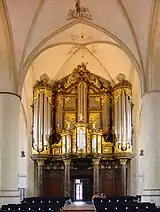 |
III/P | 47 | Hinsz completed a restoration of the Arp-Schnitger organ initiated by F.C. Schnitger; in 1740 he extended the organ. Major changes were made later, such that the organ today (III/P/52) contains only 2-3 stops from Hinsz. → Organ details |
| 1731 | Zandeweer | Hervormde Kerk | 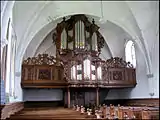 |
II/p | 16 | This was the first organ newly-built by Hinsz; its disposition was changed in the 19th and 20th centuries |
| 1733–1734 | Leens | Petruskerk | 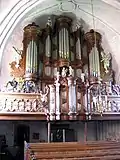 |
II/P | 27 | A new-build, modified in the 19th and 20th centuries |
| 1735–1736 | Loppersum | Hervormde Kerk | 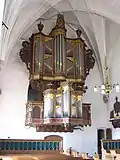 |
II/p | 20 | Hinsz added new pipework to the Hauptwerk (Great) division of an organ from 1562. In 1803, H.H. Freytag replaced the pipework of the Rückpositiv |
| 1738 | Kampen | Broederkerk | 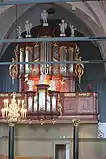 |
III/P | 32 | A new-build using ranks derived from a previous organ; rebuilt in 1822 by A. van Gruisen (II/p), extended and modified later still |
| 1738 | Utrecht | Utrecht University |  |
I/p | A new-build for the Lutheran church in Deventer, extended in 1963 to II/P/22 | |
| 1739 | Bronkhorst | Hervormd Kapel | 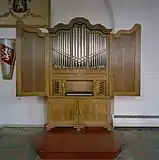 |
I | 7 | A newly-built chamber organ for Utrecht(?). The disposition was changed in the 19th century. Has been moved between various locations |
| 1741–1743 | Kampen | Bovenkerk |  |
III/p | 33 | An enlargement of the existing Slegel organ of 1676, this is Hinsz's largest organ. It was extended in 1790 by H.H. Freytag and F.C. Schnitger to give it an independent pedal and Brustwerk (IV/P/46), and later modified still further. Today's disposition is IV/P/56. → Bovenkerk Organ (Kampen) |
| 1744 | Appingedam | Nicolaikerk | 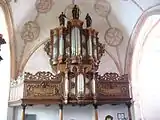 |
II/p | 20 | A new-build making use of ranks from the 16th century; well preserved |
| 1751 | Meeden | Benedictuskerk |  |
I/p | 8 | A rebuild using a large part of the pipework of the previous organ by Jost Sieburg (1643) |
| 1752/1768 | Noordbroek | Dorpskerk | 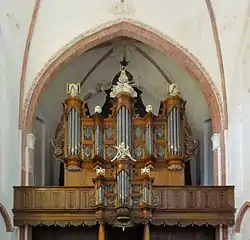 |
II/P | 24 | An enlargement of the Arp Schnitger organ of 1696, with changes in disposition; rebuilt in 1809 by H.H. Freytag; disposition further altered in 1855 by Petrus van Oeckelen → Organ of the Dorpskerk, Noordbroek |
| 1754 | Kampen | Buitenkerk | 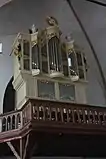 |
II/P | 20 | A new-build using older pipework |
| 1756–1758 | Peize | Hervormde Kerk | 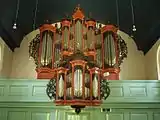 |
II/P | 22 | An enlargement of a previous organ by A. Verbeeck (1631) and Arp Schnitger (1696–1697) adding a Rückpositiv. The organ was located in the Peper-Gasthuiskerk in Groningen until 1862 |
| 1765 | Tzum | Hervormde Kerk | 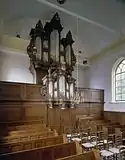 |
II/p | 20 | Rebuild of an organ by Stevens |
| 1763–1766 | Leer | Grote Kerk | 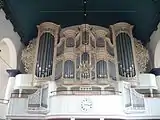 |
II/p | 21 | A major rebuild in which Hinsz created an entirely different organ from its predecessor by Marten de Mare (1609). He enlarged the Hauptwerk from its rpevious disposition and keyboard compass, provided new casework, and enlarged the Rückpositiv. Today the Organ of the Grote Kerk, Leer has a disposition of III/P/37 |
| 1766–1767 | Sexbierum | Hervormde Kerk |  |
II/P | 27 | A new-build. In 1922-1924 the pipework was entirely replaced save a single rank. Six ranks from Hinsz went to Boornbergum, one to Waaxens and four to Sebaldeburen |
| 1769 | Wassenaar | Dorpskerk | 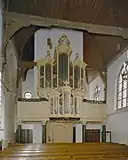 |
II/p | 13 | A new-build. In 1792 the Rückpositiv was extended by L. van Dam. Today's disposition is I/p/20 |
| 1770 | Haren | Dorpskerk | 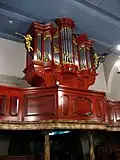 |
I/P | 13 | New build |
| 1772 | Midwolda | Hervormde Kerk |  |
II/P | 33 | A new build, remaining in its original state and in good condition |
| 1774 | Groningen | Pelstergasthuiskerk | 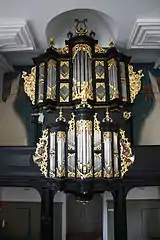 |
II/p | 20 | Enlargement of an organ by Arp Schnitger from 1693/1712. In 1875 the disposition was changed by P. van Oeckelen. → Organ of the Pelstergasthuiskerk, Groningen |
| 1775–1776 | Harlingen | Grote Kerk | 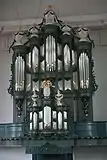 |
II/P | 34 | A new-build, subsequently modified by P. van Oeckelen in 1864. Modified again by Pieter van Dam in the early 20th Century, and various other builders since, culminating in a tonal restoration in 2011. Subsequently, the original contract for the instrument has been discovered.[1] |
| 1776–1777 | Dantumawoude | Benedictuskerk | 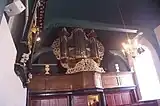 |
I/p | 8 | New-build |
| 1777–1778 | Minnertsga | Hervormde Kerk | 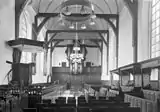 |
II/p | 20 | A new-build, destroyed by fire in 1947 |
| 1777–1780 | Roden | Hervormde Kerk | 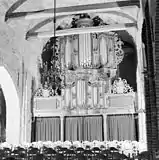 |
II/p | 17 | New-build. The organ was restored as far as possible to its original tuning, pitch and sound in 2005[2] |
| 1776–1781 | Bolsward | Martinikerk | 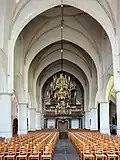 |
II/P | 34 | A new-build, extended in 1861 by L. van Dam, who added an Oberwerk. The disposition today is III/P/42 |
| 1781–1783 | Driesum | Grote Kerk |  |
I/p | 11 | A new-build that underwent various alterations in the 19th and 20th centuries |
| 1783 | Godlinze | Pancratiuskerk (Godlinze) | 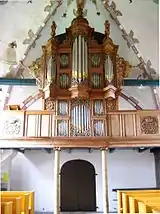 |
I/p | 12 | Hinsz rebuilt a two-manual organ by Arp Schnitger (1704) to a single-manual organ |
| 1780–1785 | Uithuizermeeden | Hervormde Kerk | 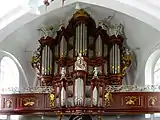 |
II/P | 28 | Hinsz's last new-build, which he did not complete; various later modifications by other builders |
Literature
- Jan Jongepier (Ed.): Een konstkundig orgelmaker. Enkele bijdragen over het werk van de orgelmaker Albertus Anthoni Hinsz (1704–1785). Stichting Groningen Orgelland, Groningen 1994, ISSN 0168-1893.
- Willem Jan Dorgelo: Albertus Anthoni Hinsz. Orgelmaker 1704–1785. Lykele Jansma, Augustinusga 1985.
- De Groninger orgelmaker Albertus Anthoni Hinsz (1704–1785). Ommelander Museum, Leens 1981.
External links
- Bolsward, Martinikerk (in Dutch)
- Bovenkerk, Kampen (in Dutch)
- Hervormde Kerk, Nordbroek
- The Hinsz organ at Appingedam is demonstrated by Sietze de Vries
- The Hinsz organ at Leens is explored by de Vries and Bálint Karosi
References
- van Dijk, Rogér; de Vries, Henk (2014). "The Hinsz organ in the Grote Kerk in Harlingen restored by Rogér van Dijk & Henk de Vries". Het ORGEL. 110 (2). Retrieved 26 November 2022.
- Peters, Peter (2009). "Retracing old organ sound. Authenticity and the structure of artistic arguments" (PDF). Krisis (1): 6–19. Retrieved 26 November 2022.